Electroless Platinum Deposition Using Co3+/Co2+ Redox Couple as a Reducing Agent
Abstract
1. Introduction
2. Materials and Methods
3. Results
4. Conclusions
Author Contributions
Funding
Institutional Review Board Statement
Informed Consent Statement
Conflicts of Interest
References
- Duflek, E.F.; Baudrand, D.W.; Donaldson, J.G. Electronic Applications of Electroless Nickel. In Electroless Plating: Fundamentals and Applications; Mallory, G.O., Hajdu, J.B., Eds.; American Electroplaters and Surface Finishers Society: Orlando, FL, USA, 1990. [Google Scholar]
- Okinaka, Y.; Osaka, T. Advances in Electrochemical Science and Engineering; Gerischer, H., Tobias, C.W., Eds.; VCH Publishers: Weinheim, Germany, 1994; Volume 3. [Google Scholar]
- Vaškelis, A. Coatings Technology Handbook, 2nd ed.; Satas, D., Tracton, A.A., Eds.; Marcel Dekker: New York, NY, USA, 2001; p. 213. [Google Scholar]
- O’Sullivan, E.J. Fundamental and Practical Aspects of the Electroless Deposition Reaction. In Advances in Electrochemical Science and Engineering; Alkire, R.C., Kolb, D.M., Eds.; Wiley-VCH: Weinheim, Germany, 2002; Volume 7, pp. 225–273. [Google Scholar] [CrossRef]
- Djokić, S.S.; Cavallotti, P.L. Modern Aspects of Electrochemistry, Electroless Deposition: Theory and Applications; Djokić, S.S., Ed.; Springer: New York, NY, USA, 2010; Volume 48, pp. 251–289. [Google Scholar]
- Mustain, W.E.; Kim, H.; Narayanan, V.; Osborn, T.; Kohl, P.A. Electroless deposition and characterization of PtxRu1−x catalysts on Pt/C nanoparticles for methanol oxidation. J. Fuel Cell Sci. Technol. 2010, 7, 041013. [Google Scholar] [CrossRef]
- Wongkaew, L.A.; Zhang, Y.; Tengco, J.M.M.; Blom, D.A.; Sivasubramanian, P.; Fanson, P.T.; Regalbuto, J.R.; Monnier, J.R. Characterization and evaluation of Pt-Pd electrocatalysts prepared by electroless deposition. Appl. Catal. B Environ. 2016, 188, 367–375. [Google Scholar] [CrossRef]
- Tate, G.; Kenvin, A.; Diao, W.; Monnier, J.R. Preparation of Pt-containing bimetallic and trimetallic catalysts using continuous electroless deposition methods. Catal. Today 2019, 334, 113–121. [Google Scholar] [CrossRef]
- Egelske, B.T.; Keels, J.M.; Monnier, J.R.; Regalbuto, J.R. An analysis of electroless deposition derived Ni-Pt catalysts for the dry reforming of methane. J. Catal. 2020, 381, 374–384. [Google Scholar] [CrossRef]
- Wagner, C.; Traud, W. Zeitschrift fur Elektrochemie und Angewandte physikalische Chemie. Z. Elektrochem. 1938, 44, 391–454. [Google Scholar] [CrossRef]
- Saito, M. Electrode oxidation reaction of formaldehyde. J. Met. Fin. Soc. Jpn. 1965, 16, 300–305. [Google Scholar] [CrossRef]
- Paunovic, M. Electrochemical aspects of electroless deposition of metals. Plating 1968, 55, 1161–1167. [Google Scholar]
- Spiro, M. Heterogeneous catalysis in solution. Part 17.—Kinetics of oxidation–reduction reaction catalysed by electron transfer through the solid: An electrochemical treatment. J. Chem. Soc. Faraday Trans. 1979, 75, 1507–1512. [Google Scholar] [CrossRef]
- Vitry, V.; Bonin, L. Increase of boron content in electroless nickel-boron coating by modification of plating conditions. Surf. Coat. Technol. 2017, 311, 164–171. [Google Scholar] [CrossRef]
- Bonin, L.; Castro, C.C.; Vitry, V.; Hantson, A.-L.; Delaunois, F. Optimization of electroless NiB deposition without stabilizer, based on surface roughness and plating rate. J. Alloys Comp. 2018, 767, 276–284. [Google Scholar] [CrossRef]
- Algul, H.; Uysal, M.; Alp, A. A comparative study on morphological, mechanical and tribological properties of electroless NiP, NiB and NiBP coatings. Appl. Surf. Sci. Adv. 2021, 4, 100089. [Google Scholar] [CrossRef]
- Zhang, Y.; Yan, Z.; Zhang, M.; Tan, Y.; Jia, S.; Liu, A. Green electroless plating of cuprous oxide nanoparticles onto carbon nanotubes as efficient electrocatalysts for hydrogen evolution reaction. Appl. Surf. Sci. 2021, 548, 149218. [Google Scholar] [CrossRef]
- Zhang, B. Green Electroless Plating. In Amorphous and Nano Alloys Electroless Depositions; Elsevier Inc.: Amsterdam, The Netherlands, 2016; pp. 583–627. [Google Scholar] [CrossRef]
- Vaškelis, A.; Jačiauskienė, J.; Norkus, E. The kinetics of autocatalytic Cu (II) reduction by Co (II) complexes. Chemija 1995, 3, 16. [Google Scholar]
- Vaškelis, A.; Norkus, E.; Rozovskis, G.; Vinkevičius, H.J. New methods of electroless plating and direct electroplating of plastics. Trans. IMF 1997, 75, 1–3. [Google Scholar] [CrossRef]
- Jusys, Z.; Stalnionis, G. Autocatalytic reduction of Cu(II) to copper by Co(II) studied by electrochemical quartz crystal microgravimetry in a wall jet cell. J. Electroanal. Chem. 1997, 431, 141–144. [Google Scholar] [CrossRef]
- Vaškelis, A.; Norkus, E.; Reklaitis, J.; Jačiauskienė, J. Electroless copper plating using cobalt(II)-ethylenediamine complex compounds as reducing agents: 1. The thermodynamical aspects. Chemija 1998, 3, 199–205. [Google Scholar]
- Norkus, E.; Vaškelis, A.; Jačiauskienė, J. Electroless copper plating using cobalt(II)-ethylenediamine complex compounds as reducing agents: 2. A kinetic study. Chemija 1998, 4, 284–290. [Google Scholar]
- Vaškelis, A.; Norkus, E. Autocatalytic processes of copper(II) and silver(I) reduction by cobalt(II) complexes. Electrochim. Acta 1999, 44, 3667–3677. [Google Scholar] [CrossRef]
- Vaškelis, A.; Norkus, E.; Jačiauskienė, J.; Reklaitis, J. Stromlose Verkupferung mit Kobalt(II)-Ethylendiamin-Komplexverbindungen als Reduktionsmittel. Thermodynamische Aspekte und kinetische Untersuchungen. Galvanotechnik 1999, 90, 1556–1569. [Google Scholar]
- Vaškelis, A.; Stalnionis, G.; Jusys, Z. Cyclic voltammetry and quartz crystal microgravimetry study of autocatalytic copper(II) reduction by cobalt(II) in ethylenediamine solutions. J. Electroanal. Chem. 1999, 465, 142–152. [Google Scholar] [CrossRef]
- Jusys, Z.; Stalnionis, G. Wall-jet electrochemical quartz crystal microgravimetry: Oxidation of Co(II)–ethylenediamine complexes on copper electrode. Electrochim. Acta 2000, 45, 3675–3682. [Google Scholar] [CrossRef]
- Vaškelis, A.; Norkus, E.; Jačiauskienė, J. Kinetics of electroless copper deposition using cobalt(II)-ethylenediamine complex compounds as reducing agents. J. Appl. Electrochem. 2002, 32, 297–303. [Google Scholar] [CrossRef]
- Vaškelis, A.; Jačiauskienė, J.; Jagminienė, A.; Norkus, E. Obtaining of IB group metal films by novel electroless deposition method. Solid State Sci. 2002, 4, 1299–1304. [Google Scholar] [CrossRef]
- Dordi, Y.; Thie, W.; Vaškelis, A.; Norkus, E.; Jačiauskienė, A.; Jagminienė, A. Plating Solutions for Electroless Deposition of Copper. U.S. Patent US7297190B1, 20 November 2007. [Google Scholar]
- Vaškelis, A.; Norkus, E.; Jačiauskienė, A.; Jagminienė, A. Plating Solution for Electroless Deposition of Copper. U.S. Patent US7306662B2, 11 December 2007. [Google Scholar]
- Vaškelis, A.; Stankevičienė, I.; Jagminienė, A.; Tamašauskaitė-Tamašiūnaitė, L.; Norkus, E. The autocatalytic reduction of copper(II) by cobalt(II) in aqueous diethylenetriamine solutions studied by EQCM. J. Electroanal. Chem. 2008, 622, 136–144. [Google Scholar] [CrossRef]
- Norkus, E.; Stankevičienė, I.; Tamašauskaitė-Tamašiūnaitė, L.; Stalnionis, G.; Prušinskas, K.; Jagminienė, A. EQCM and CV study of autocatalytic copper(II) reduction by cobalt(II) pentaethylenehexamine complexes in wide pH range. J. Electrochem. Soc. 2014, 161, D373–D380. [Google Scholar] [CrossRef]
- Vaškelis, A.; Jagminienė, A.; Juškėnas, R.; Matulionis, E.; Norkus, E. Structure of electroless silver coatings obtained using cobalt(II) as reducing agent. Surf. Coat. Technol. 1996, 82, 165–168. [Google Scholar] [CrossRef]
- Norkus, E.; Vaškelis, A.; Jagminienė, A.; Tamašauskaitė-Tamašiūnaitė, L. Kinetics of electroless deposition using cobalt(II)-ammonia complex compounds as reducing agents. J. Appl. Electrochem. 2001, 31, 1061–1066. [Google Scholar] [CrossRef]
- Norkus, E.; Stankevičienė, I.; Jagminienė, A.; Tamašauskaitė-Tamašiūnaitė, L.; Joi, A.; Dordi, Y. Electroless Deposition of Continuous Platinum Layer Using Complexed Co2+ Metal Ion Reducing Agent. U.S. Patent US9499913B2, 22 November 2016. [Google Scholar]
- Sauerbrey, G.Z. The use of quartz oscillators for weighing thin layers and for microweighing. Z. Phys. 1959, 155, 206–222. [Google Scholar] [CrossRef]
- Buttry, D.A.; Ward, M.D. Measurement of interfacial processes at electrode surfaces with the electrochemical quartz crystal microbalance. Chem. Rev. 1992, 92, 1355–1379. [Google Scholar] [CrossRef]
- Norkus, E.; Vaškelis, A.; Grigucevičienė, A.; Rozovskis, G.; Reklaitis, J.; Norkus, P. Oxidation of cobalt(II) with air oxygen in aqueous ethylenediamine solutions. Trans. Met. Chem. 2001, 26, 465–472. [Google Scholar] [CrossRef]
- Norkus, E.; Stankevičienė, I.; Tamašauskaitė-Tamašiūnaitė, L.; Prušinskas, K. Comparative study of electroless copper deposition using different cobalt(II)-amine complex compounds as reducing agents. Chemija 2012, 23, 1–6. [Google Scholar]
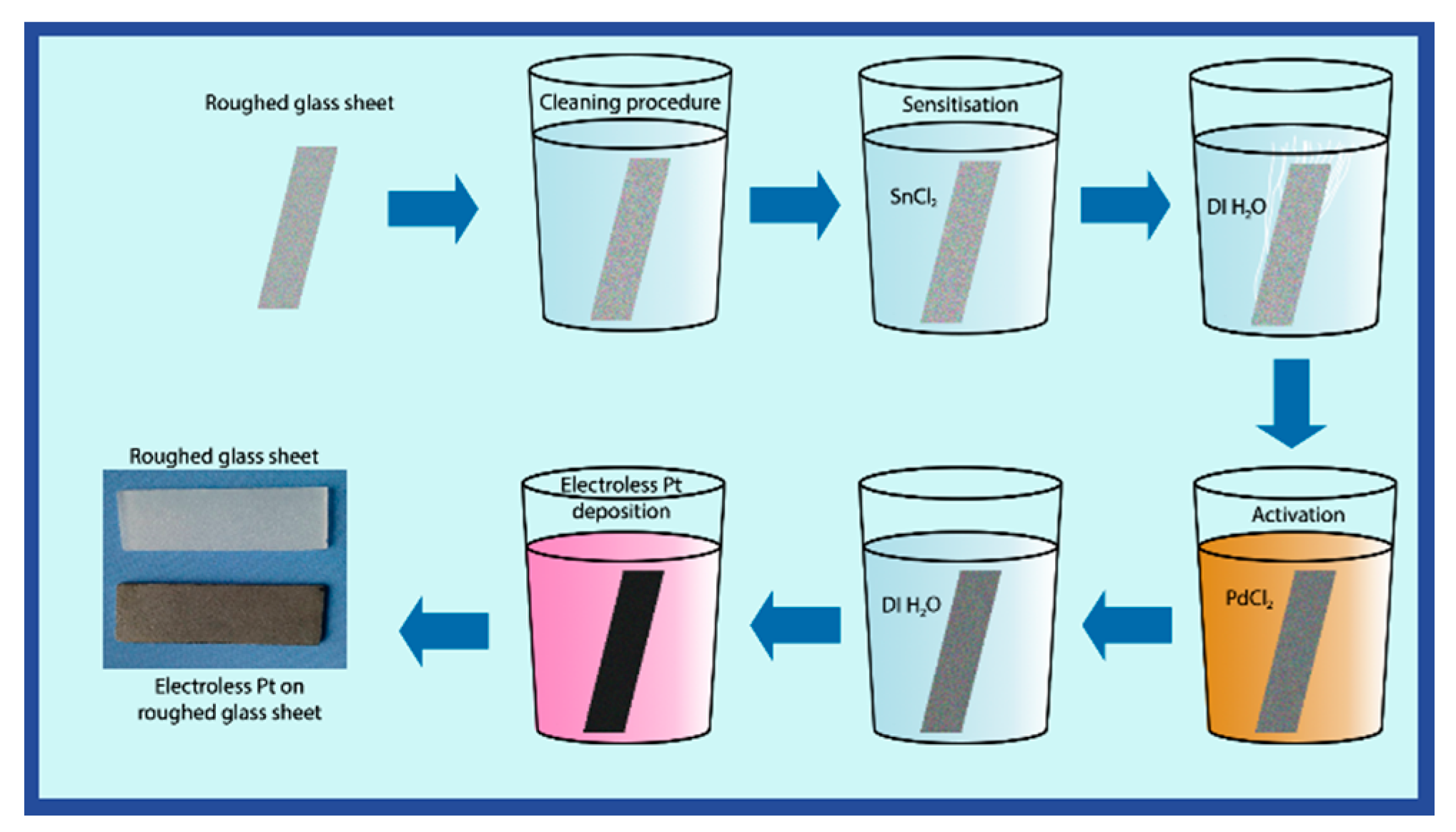
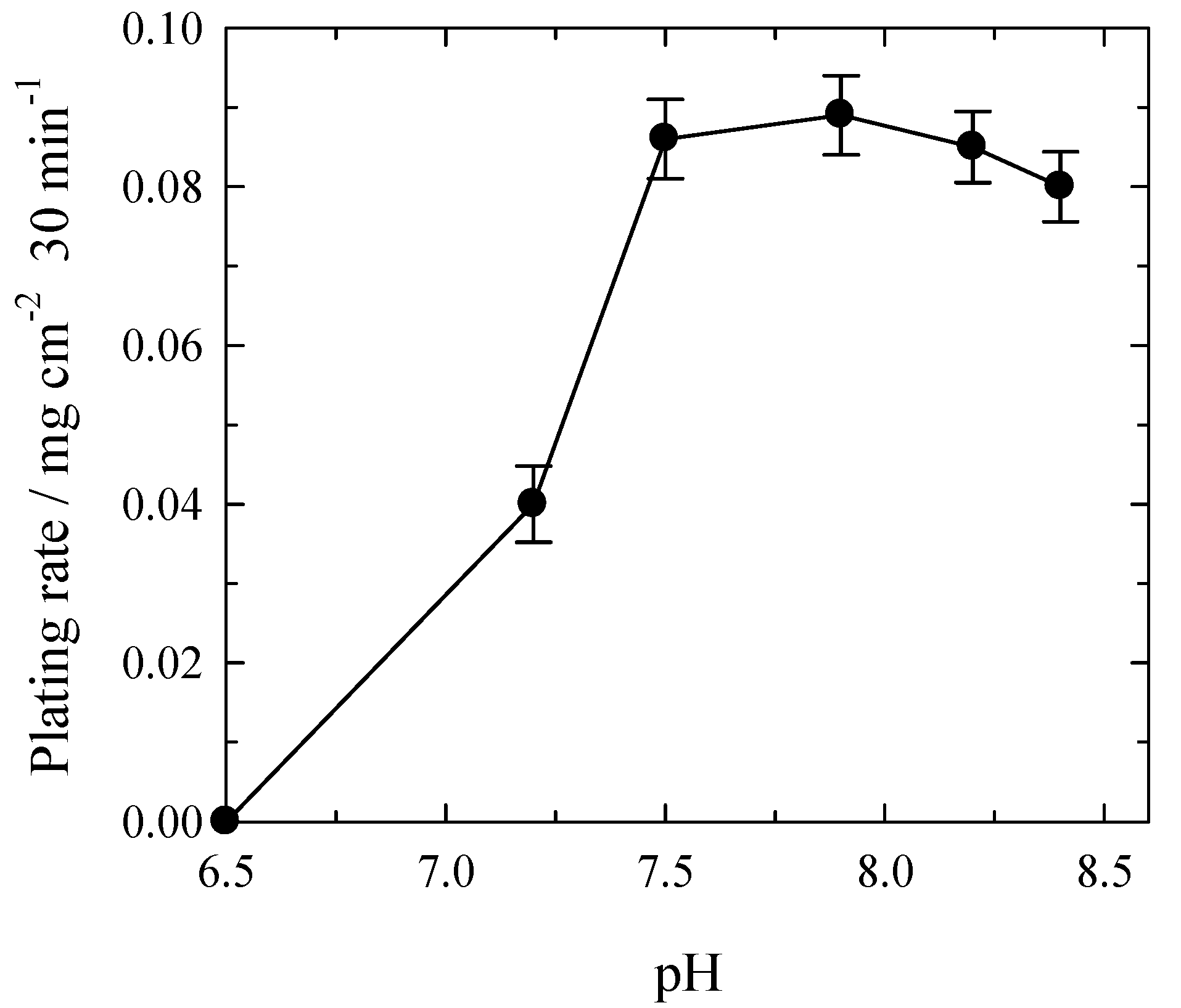
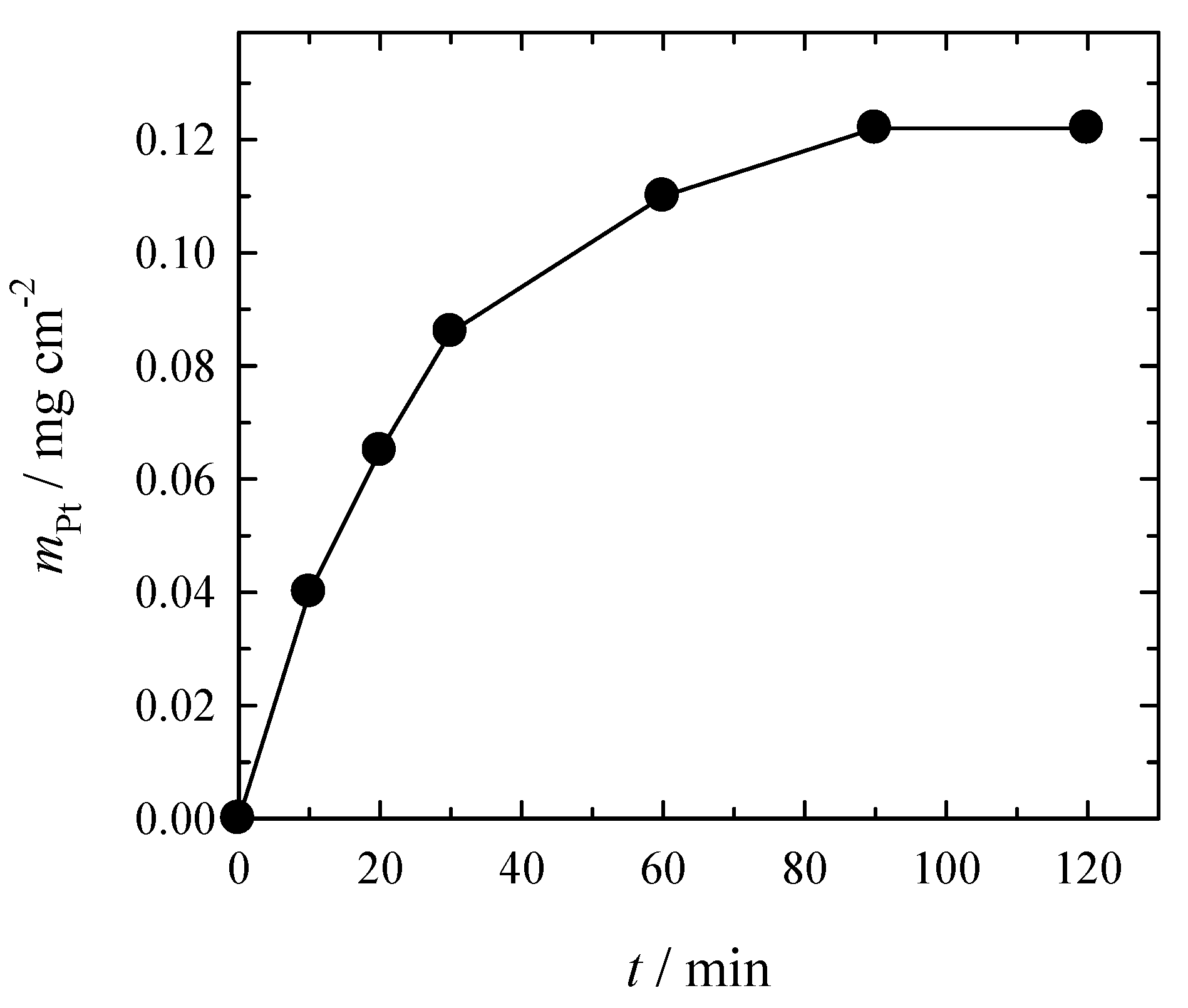
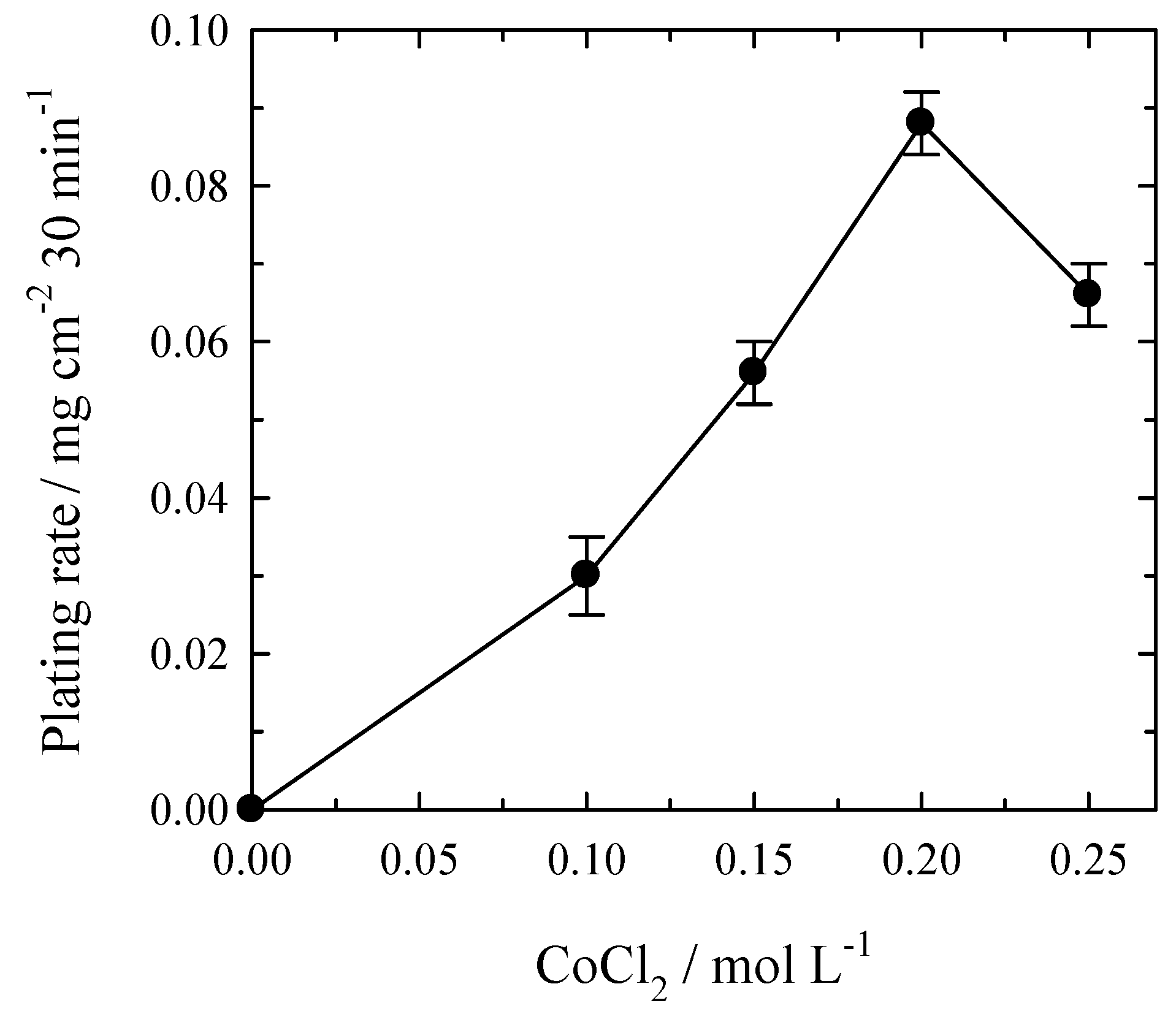
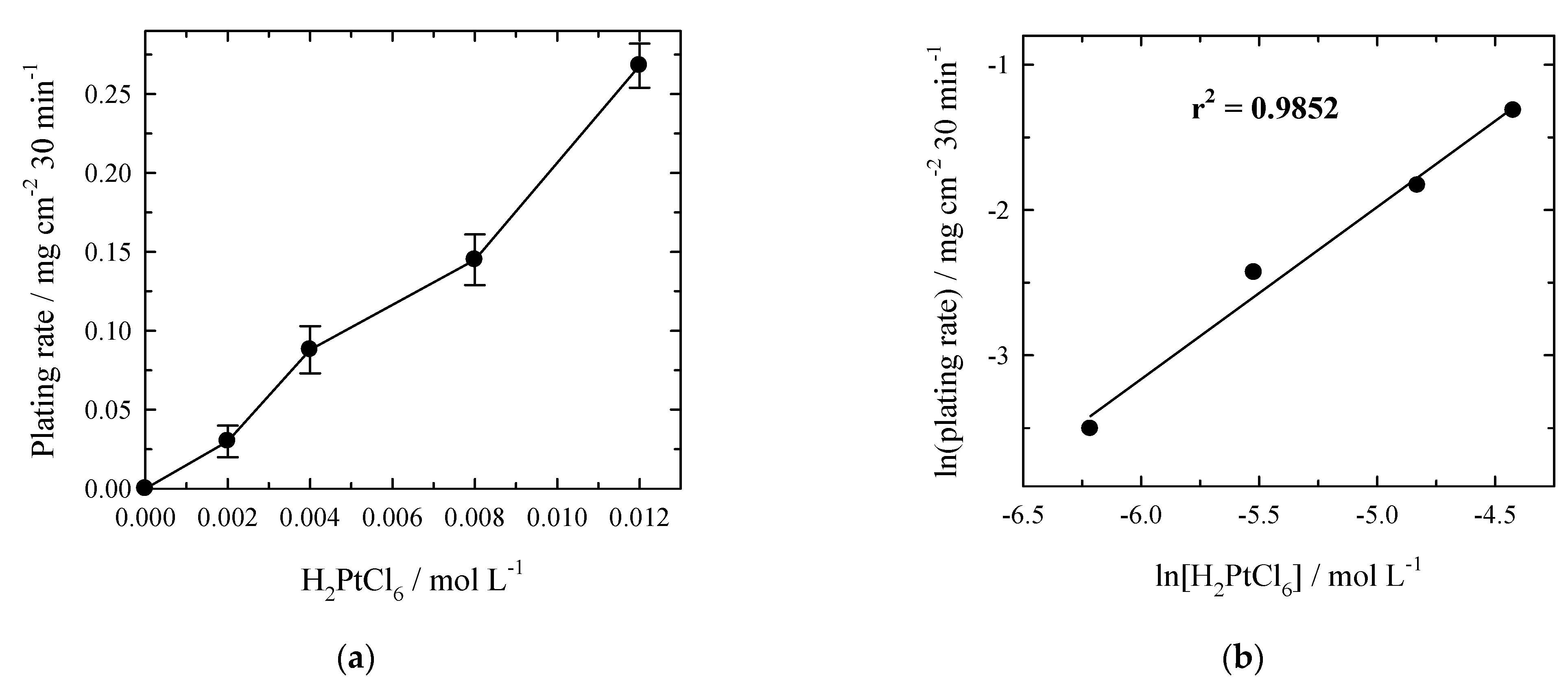
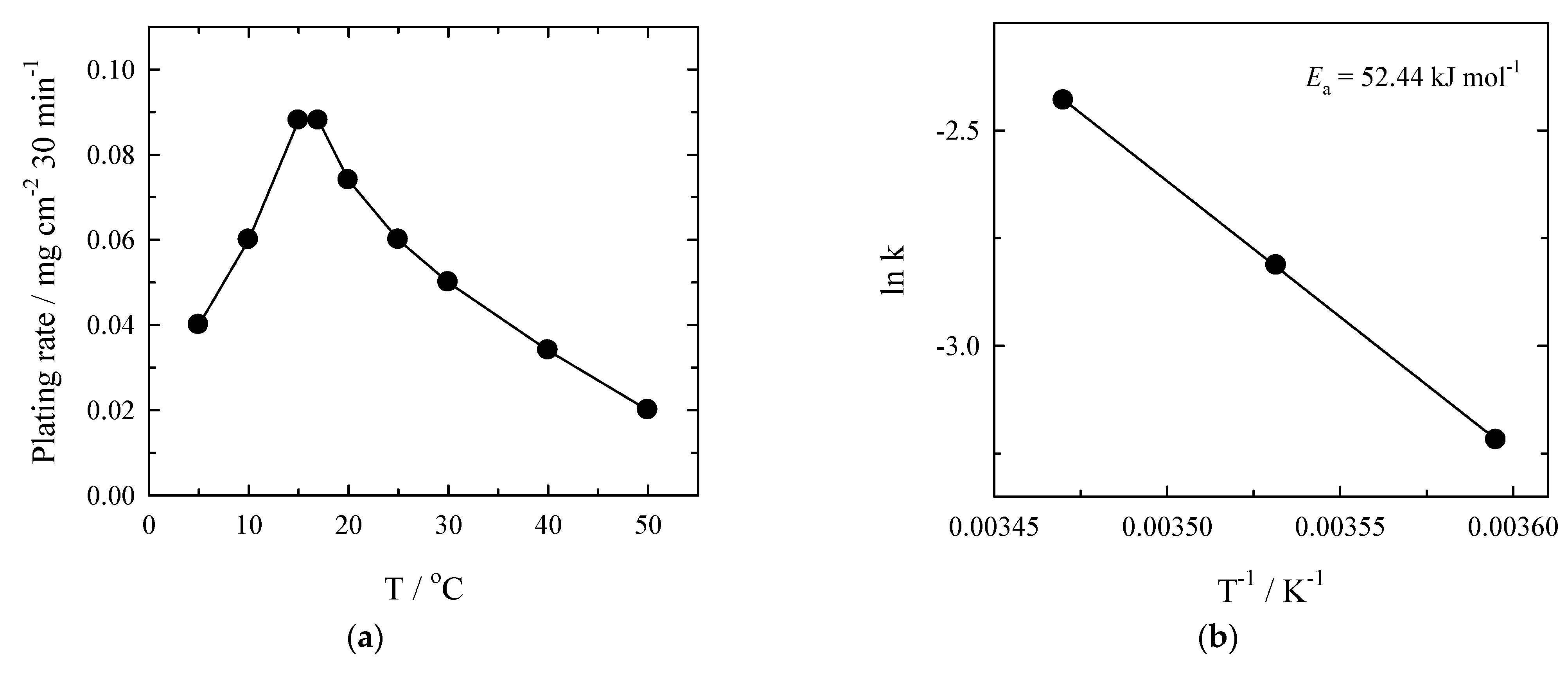

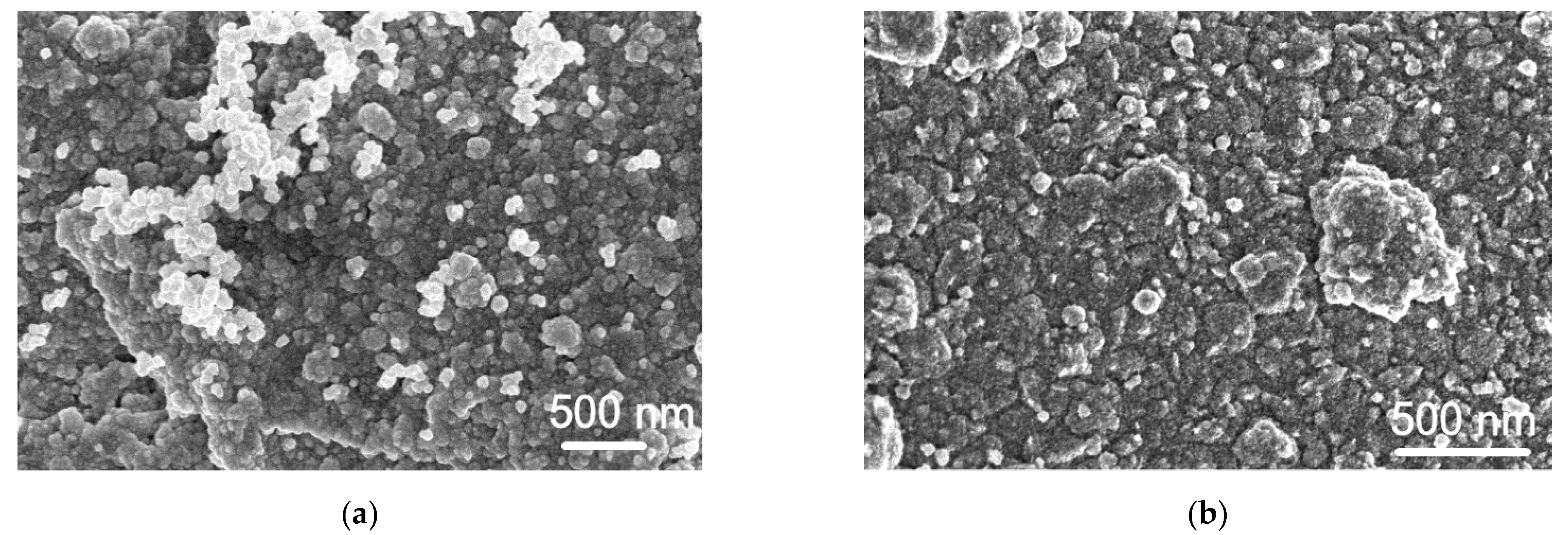

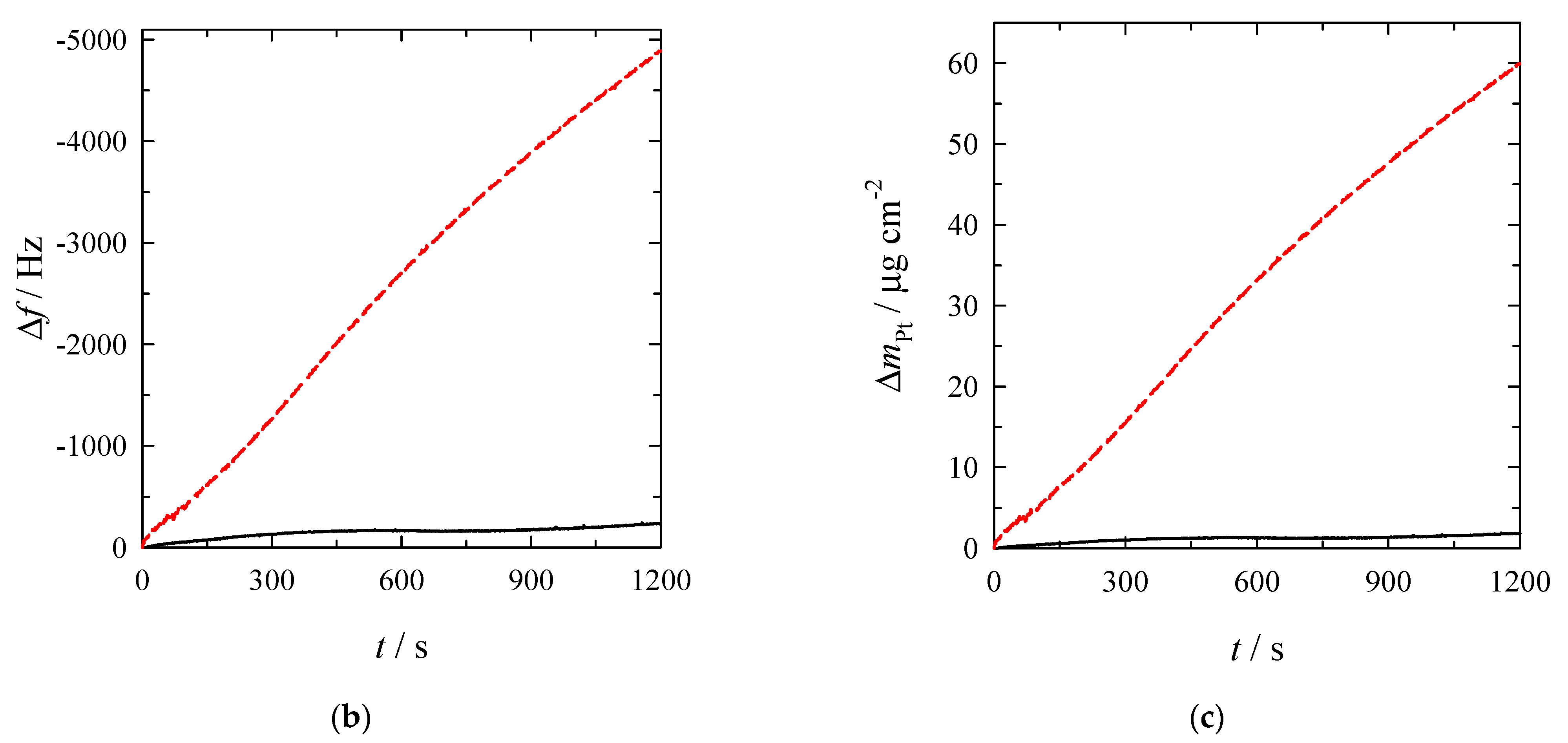
Publisher’s Note: MDPI stays neutral with regard to jurisdictional claims in published maps and institutional affiliations. |
© 2021 by the authors. Licensee MDPI, Basel, Switzerland. This article is an open access article distributed under the terms and conditions of the Creative Commons Attribution (CC BY) license (https://creativecommons.org/licenses/by/4.0/).
Share and Cite
Tamasauskaite-Tamasiunaite, L.; Dordi, Y.; Norkus, E.; Stankeviciene, I.; Jagminiene, A.; Naujokaitis, A.; Tumonis, L.; Buzas, V.; Maciulis, L. Electroless Platinum Deposition Using Co3+/Co2+ Redox Couple as a Reducing Agent. Materials 2021, 14, 1893. https://doi.org/10.3390/ma14081893
Tamasauskaite-Tamasiunaite L, Dordi Y, Norkus E, Stankeviciene I, Jagminiene A, Naujokaitis A, Tumonis L, Buzas V, Maciulis L. Electroless Platinum Deposition Using Co3+/Co2+ Redox Couple as a Reducing Agent. Materials. 2021; 14(8):1893. https://doi.org/10.3390/ma14081893
Chicago/Turabian StyleTamasauskaite-Tamasiunaite, Loreta, Yezdi Dordi, Eugenijus Norkus, Ina Stankeviciene, Aldona Jagminiene, Arnas Naujokaitis, Liudas Tumonis, Vytenis Buzas, and Laurynas Maciulis. 2021. "Electroless Platinum Deposition Using Co3+/Co2+ Redox Couple as a Reducing Agent" Materials 14, no. 8: 1893. https://doi.org/10.3390/ma14081893
APA StyleTamasauskaite-Tamasiunaite, L., Dordi, Y., Norkus, E., Stankeviciene, I., Jagminiene, A., Naujokaitis, A., Tumonis, L., Buzas, V., & Maciulis, L. (2021). Electroless Platinum Deposition Using Co3+/Co2+ Redox Couple as a Reducing Agent. Materials, 14(8), 1893. https://doi.org/10.3390/ma14081893






